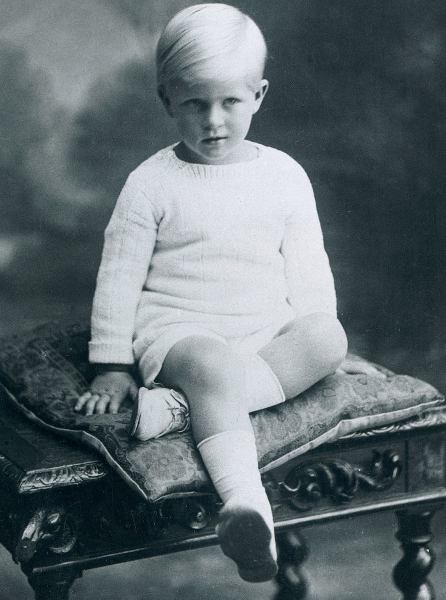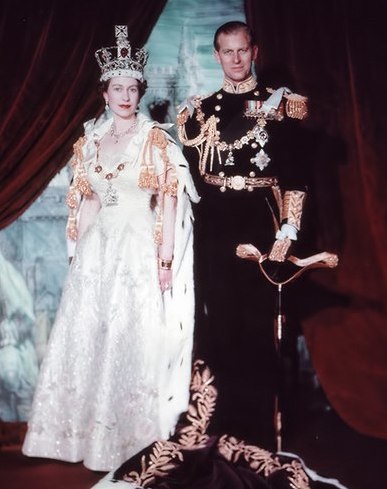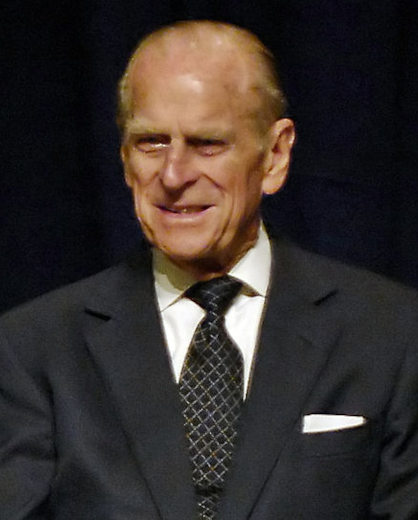1921-2021
Prince Philip of Greece and Denmark, consort of Queen Elizabeth II, is the only son of Prince Andrew of Greece and Denmark and Princess Alice of Battenberg He was born on a kitchen table on the Greek island of Corfu on 10 June 1921. Philip was Prince Andrew and Princess Alice's only son, at the time of his birth they already had four daughters, Sophia, Margarita, Cecilie and Theodora.
Philip's ancestry is mainly German, Danish and Russian. Prince Andrew descended in the male line from the Danish Royal family, the House Schleswig-Holstein-Sonderburg-Glücksburg, which itself was of both mixed German and Danish descent. Andrew was a younger son of Prince William of Greece and Denmark, who was invited to take up the vacant Greek throne in 1863 and adopted the regnal name of George I. His paternal grandmother, Grand Duchess Olga Constantinovna of Russia of the House of Romanov, which by the time of her birth, was primarily of German descent. Philip's mother, Princess Alice of Battenberg, was the daughter of Prince Louis of Battenberg and Princess Victoria of Hesse. Her sister Louise became the Queen of Sweden and she had two brothers, George, Marquess of Milford Haven and Louis, Earl Mountbatten of Burma. Victoria was herself the daughter of Princess Alice, the second daughter of Queen Victoria. This made Philip both the 3rd cousin of his future wife, Queen Elizabeth II through their shared descent from Queen Victoria and second cousins through their mutual descent from King Christian IX of Denmark.
In 1922, following the abdication of Philip's uncle, King Constantine I, Prince Andrew was arrested by the Greek Military Government. He was banished for life from Greece. The British warship, HMS Calypso was sent to evacuate Andrew and his young family, the baby Philip was reportedly carried on board in an orange box. The family then settled in the outskirts of Paris in a house-made available to them by more wealthy relatives.
Philip as a child
Princess Alice turned frequently to religion after the trauma of the family's exile she began hearing voices and believed she was having physical relationships with Christ and other religious figures. The troubled Princess was diagnosed with paranoid schizophrenia and was removed by her family and placed in Ludwig Binswanger's sanatorium in Kreuzlingen, Switzerland. On the day she left, the nine-year-old Philip was taken out by his grandmother for a picnic. When he returned, his mother had gone. Alice made several unsuccessful attempts to leave the asylum she was subjected to X-raying her ovaries in order to kill off her libido when Sigmund Freud suggested the delusions she suffered from were the result of sexual frustration.
During this time Alice and her husband drifted apart, their daughters all married German princes and the young Prince Philip went to stay with his maternal uncles Lord Louis Mountbatten and George Mountbatten, 2nd Marquess of Milford Haven, as well as his grandmother Victoria of Hesse, Dowager Marchioness of Milford Haven. Prince Andrew himself moved to Monte Carlo and took up a playboy lifestyle with his mistress.
For the rest of his childhood, Philip had little contact with his mother. When Alice was eventually released from the sanatorium in 1932, she became a lonely drifter, staying in modest German B&Bs. In 1933, he attended Schule Schloss Salem in Germany, with the rise of Nazism, the school's Jewish founder, Kurt Hahn, fled to Britain and founded Gordonstoun School in Scotland, to which Philip was transferred. Mother and son were not to meet again until tragic circumstances forced them together, reuniting in 1937 at the funeral of Philip’s sister Cécilie, who’d died in a plane crash at the age of 26. Cecilie, 8 months pregnant with her fourth child, her husband Georg Donatus, Hereditary Grand Duke of Hesse and their children, perished in an air accident at Ostend when flying from Germany to London to attend a family wedding. Rescue workers found the remains of an infant, prematurely delivered before the plane crashed, lying beside Cecile’s body, suggesting the pilot tried to land as labour had commenced. Years later Philip was to recall ‘I have the very clearest recollection of the profound shock with which I heard the news of the crash and the death of my sister and her family.’ The following year, Philips guardian, George Mountbatten, died of cancer.
Naval Career
On leaving Gordonstoun in 1939, the then-teenage Philip served as a cadet at the Royal Naval College, Dartmouth. On completing this he returned to his Greek homeland, where he stayed with his mother in Athens for a month before he returned to Britain in September to resume training for the Royal Navy and graduated the following year. During the Second World War, he continued to serve in the British forces, while two of his sister's husbands, fought on the opposing German side. After Italy invaded Greece in October 1940, he was transferred from the Indian Ocean to the battleship HMS Valiant in the Mediterranean Fleet.
Philip was commissioned as a sub-lieutenant in 1941. Among other engagements, he was involved in the battle of Crete and was mentioned in dispatches for his service during the Battle of Cape Matapan In June 1942, he was appointed to the destroyer HMS Wallace, which was involved in convoy escort tasks on the east coast of Britain, as well as the Allied invasion of Sicily. Promotion to the rank lieutenant occurred on 16 July 1942. In October of the same year, he became first lieutenant of HMS Wallace, at 21 years old one of the youngest first lieutenants in the Royal Navy. During the invasion of Sicily, in July 1943, as second in command of HMS Wallace, he saved his ship from a night bomber attack.
Marriage to Elizabeth II
George VI and Queen Elizabeth toured the Royal Naval College in 1939. Lord Mountbatten suggested that his nephew Philip should escort the King's two daughters, Princesses Elizabeth and Margaret, The thirteen-year-old Elizabeth was impressed by the handsome blonde Philip, five years her senior, and the pair began to correspond by letter and the pair became close. In the summer of 1946, Philip asked King George VI for his eldest daughter's hand in marriage. The King, who considered his daughter hadn't had the opportunity to meet many young men yet and viewed the sensitive issue of Philip's with concern, announced that a formal engagement should be delayed until her 21st birthday which was to take place the following April. In March 1947, Philip abandoned his Greek and Danish royal titles and adopted the surname Mountbatten which was his mother's family's surname. Elizabeth's mother had reservations about the union initially, and was said to have referred to Philip as "The Hun". The couple's engagement was nevertheless publicly announced on 10 July 1947.
Queen Elisabeth and the Duke of Edinburgh
On the evening of the wedding, Philip was designated a royal highness and was created a Knight of the Garter, Baron Greenwich, Earl of Merioneth, and the duke of Edinburgh. The couple were married on 20 November 1947 at Westminster Abbey. In the days of post-war austerity, the bride to be required ration coupons to pay for her dress, the designer was Norman Hartnell. To avoid negative publicity in Britain, Philip's German relations, including his three surviving sisters were not invited to the event, although his mother attended.
The couple welcomed their first child, Prince Charles Philip Arthur George, on 14 November 1948. A daughter, Princess Anne Elizabeth Alice Louise, followed in in 1950. Philip continued on naval service until after the death of George VI and Elizabeth’s accession as Queen on February 6, 1952. Philip was dismayed when at the insistence of his mother-in-law, Queen Elizabeth and the Queen's grandmother Queen Mary allied to Winston Churchill insisted that Windsor should be the surname of the royal house and therefore his children were not to bear his surname. He complained in irritation "Im a bloody Amoeba" In 1957 the Queen appointed him as a prince of the United Kingdom, and in 1960 his surname was legally combined with the name of her family as Mountbatten-Windsor, to be used as a surname for the less senior branches of the royal family.
With the failing health of George VI, who was suffering from lung cancer, Philip and Elizbeth stood in for the King and Queen and embarked on a tour of the Commonwealth. On 6 February 1952, they were at Sagana Lodge in a remote part of Kenya when George VI died in his sleep at Sandringham, making Elizabeth the new sovereign. Philip broke the news to her, after which they immediately returned to Britain.
Eight years into her reign Elizabeth gave birth to what is often referred to as her 'second family. Prince Andrew Albert Christian Edward arrived in 1960 and was followed by the couples fourth and last child, Edward Antony Richard Louis, in 1964. Prince Philip decided to send Prince Charles to his old school of Gordonstoun in Scotland, he hoped the spartan regime there would toughen up his son. The sensitive Charles, however, loathed it and was desperately unhappy. The Queen mother, who enjoyed a close relationship with her grandson objected, she would have preferred him to go to Eton but was overruled.
In her later years, Elizabeth and Philip invited his mother Princess Alice, who was increasingly deaf and in failing health, to live permanently at Buckingham Palace. She died there on 5 December 1969. Shortly before her death, she wrote to her only son, whose childhood had been so scarred by her absence, ‘Dearest Philip, Be brave, and remember I will never leave you, and you will always find me when you need me most. All my devoted love, your old Mama.’
The assassination of Philip's uncle, Lord Mountbatten, by the provisional IRA in 1980, shook the royal family to the core, particularly affecting the sensitive Prince Charles. Mountbatten had been spending a family holiday at his second home of Mullaghmore, County Sligo, when a bomb, which had been planted on his boat in Donegal Bay had exploded. Prince Charles had shared a particularly close relationship with his great-uncle and mentor, referring to him as his "honorary grandfather", he was known to find communication with his father difficult. Mountbatten was given a state funeral at Westminster Abbey at which a visibly shaken Charles read the lesson.
The Duke of Edinburgh in his later years
Unmarried at 30, the Prince of Wales love life became a hot topic for the tabloids. Charles was at the time conducting a relationship with the nineteen-year-old Lady Dian Spencer, Philip, in his usual forthright manner wrote to his son advising him to make up his mind to either propose to Lady Diana or end their relationship. Charles felt pressured by his father to make a decision and did so, proposing to Diana. The 1981 marriage of the Prince of Wales to Lady Diana Spencer ran into difficulties even in its early stages. Ill matched from the outset, both partners had engaged in extra-marital affairs and their marriage had become little more than a sham, endured by both parties for the benefit of the public. Their problems were endlessly very publicly aired and Charles infidelities exposed in a book by Andrew Morton, with whom the Princess collaborated. The Prince and Princess of Wales drew the monarchy into further disrepute by their ongoing feud and public point-scoring over each other, which the press dubbed the War of the Waleses. After the Princess appeared on the television programme, Panorama, admitting involvement in Morton's book and an affair with an army officer, Major James Hewitt, the Queen advised them to divorce, for the sake of their children and to limit the escalating damage to the monarchy. Philip had tried to help offering Princess Diana support and advice in letters signed 'Papa'.
The marriage of the Prince and Princess of Wales ended on 28th August 1996. On the death of the much loved and immensely popular Diana in a car accident in Paris on 31st August 1997, the Prince of Wales' popularity reached its nadir. He and the royal family came under criticism for what the public perceived as its ill-treatment of Diana and they were accused by the press of being cold and unfeeling, slow to react to and out of tune with the feelings of the nation. Prince Philip supported his young grandsons, William and Harry, walking beside them in the funeral cortege behind their mother's coffin.
Prince Philip is particularly interested in science, industry, and engineering. He also had a flair for art and in his youth, he was a keen polo player and in later life took up the sport of carriage driving. Environmental and conservation issues are also close to his heart. He founded The Duke of Edinburgh Award in 1956 which has since expanded to 144 countries. The award recognises adolescents and young adults for completing a series of self-improvement exercises modelled on Kurt Hahn's solutions to his "Six Declines of Modern Youth".
Philip and the Queen have a total of eight grandchildren and to date, ten great-grandchildren. Both Zara Tindall and Princess Eugenie of York have 'Philip' as their son's names in honour of their great-grandfather. Ill health and gradually increasing frailty led to Prince Philip retirement from his duties as the Queen's consort in 2017. Amidst the growing family crisis triggered by the Duke and Duchess of Sussex' interview with Oprah Winfrey Philip was admitted to King Edward VII's Hospital after feeling unwell. He was visited there by his eldest son Prince Charles. A successful operation for his heart condition was carried out. After spending a month in hospital he was discharged, returning to Windsor Castle to be with the Queen.
The prince died peacefully at Windsor Castle on 9 April 2021, aged 99. He was the longest-serving royal consort in British history. The queen was by his side at the end. His most important role has been as a loving and supportive husband.
The Duke was interred at the Royal Vault at Windsor, following a funeral service held at St. George's Chapel on 17th April 2021. Attendance at the funeral was limited due to the coronavirus regulations, with only 30 mourners allowed, these included the Queen, Philip's 4 children and 8 grandchildren and their spouses, as well as the Earl of Snowdon and Lady Sarah Chatto, the children of Princess Margaret, the Dukes of Gloucester and Kent and Princess Alexandra of Kent. Bernhard, Hereditary Prince of Baden, Prince Donatus, Landgrave of Hesse, Philipp, Prince of Hohenlohe-Langenburg, descendants of Prince Philip's sisters and Penelope Knatchbull, Countess Mountbatten of Burma also attended. His body is to be moved to the King George VI Memorial Chapel on the death of the Queen.
Mary of Teck PreviousNext Elizabeth Bowes-Lyon
